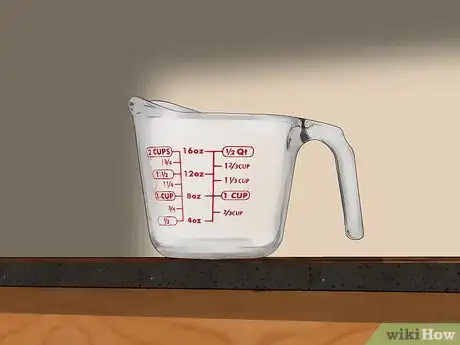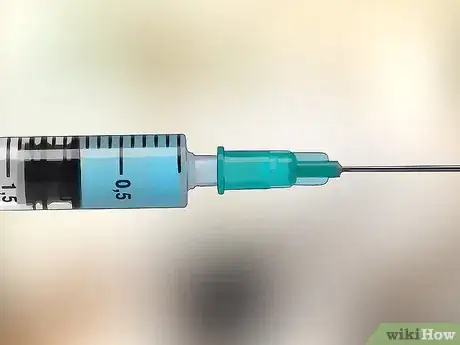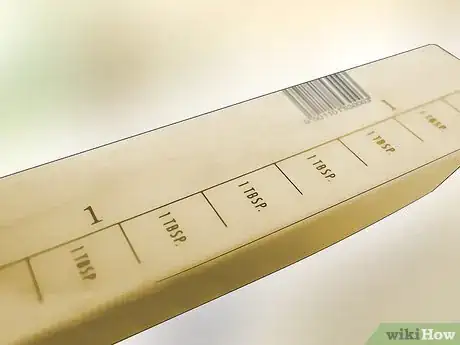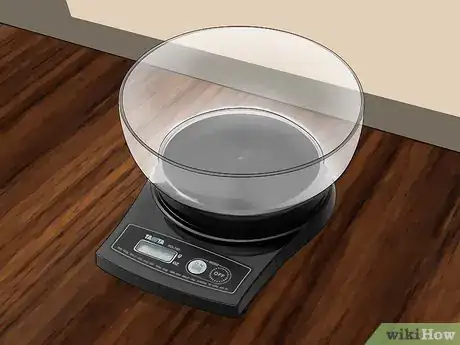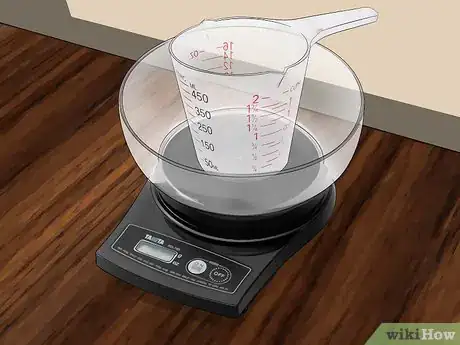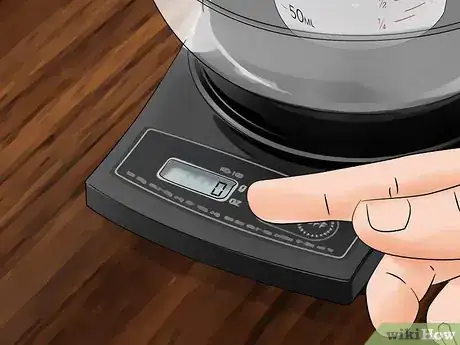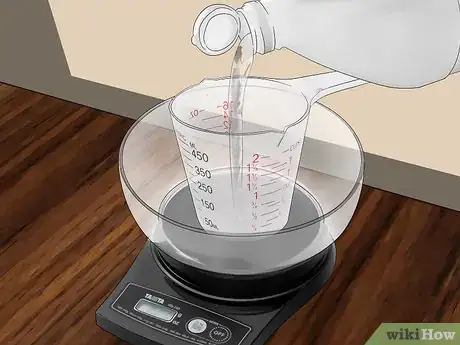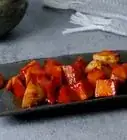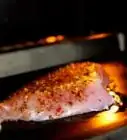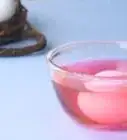This article was co-authored by Bill Holdenstern. Bill Holdenstern is a Baker and the Co-Owner of East Bay Pie Co. in San Francisco, California. With over 10 years of experience in the food industry, he specializes in making pot pies filled with flavors from around the world. Bill trained with chefs in multiple restaurants and studied business at Bunker Hill Community College. East Bay Pie Co has been profiled in The Manual, Purple List, and Nosh.
There are 10 references cited in this article, which can be found at the bottom of the page.
This article has been viewed 74,138 times.
Good baking starts with good measurements. Taking good measurements, however, is not as simple as buying a set of dry measuring cups and having done with it all. Different wet ingredients require different methods of measurement. Measuring them properly is important because the ratio of wet to dry ingredients in a recipe can greatly alter its texture and appearance. By reading the meniscus on a liquid measuring cup, making sure sticky ingredients don't stick to your utensils, or even using a scale for improved accuracy, you'll be able to accurately measure liquid ingredients in every recipe.
Steps
Using a Cup for Thin Liquids
-
1Start with a liquid measuring cup. Liquid measuring cups are the most accurate way to measure thin liquids, like water, milk, juice, and oils. They are made of transparent glass or plastic, and have markings on the sides to indicate volume in both metric and English units. You can find one at a grocery store, big-box store, kitchen-supply store, or even a dollar store.[1]
-
2Place the cup on a flat surface. You won’t get as accurate a measurement if you’re holding the cup in your shaky hands, so set it on a counter or table. Now, pour the liquid in, until it reaches the correct line. Pour slowly, so you don’t have to worry about getting rid of excess.Advertisement
-
3Find the meniscus. Crouch or lean down, so your eyes are level with the measurement line you’ve chosen. You will see a slight concave curve in the surface of the liquid. Make sure that the bottom of this arc, called the meniscus, touches the measurement line.[2]
-
4Use a measuring spoon for small quantities. If you’re measuring less than a quarter cup of a thin liquid--for instance, vanilla extract--use a measuring spoon to dole it out. Hold the spoon over a separate bowl to catch any overflow, and gently pour in the liquid until it’s full. Empty the spoon into the recipe, and continue.[3]
-
5Measure very small amounts of ingredients with a syringe. It may look intimidating, but this tool will give you hyper-accurate results for small volumes. If you’re doing precision baking, a trip to the drugstore can net you a very useful syringe. Fill it up to the desired volume line according to the package directions, then squirt the liquid into the recipe.[4]
Dealing with Thick or Sticky Substances
-
1Avoid sticky situations with cooking oil. Some sweeteners, like honey and molasses, are reluctant to leave the measuring cup once they’re there. (The good news is that they’re easier to eyeball--they are too thick to have a meniscus.) To encourage these syrups to slip out more easily, pour them into a liquid measuring cup that has been sprayed with cooking oil.[5]
- To save even more time, in recipes in which you are measuring both oil and honey or molasses, measure the oil first, pour it into the recipe, then measure the sweetener.[6]
-
2Measure malleable solids in a solid cup. Some ingredients, like shortening and yogurt, are definitely not as runny as water. However, they’re too thick to measure using the dip-and-sweep method you might use for flour or sugar. In this case, it’s best to use a solid measuring cup and pack in the shortening or yogurt, using the back of a spoon to press it down firmly.
- Line the cup with plastic wrap to make removal easier.[7]
- Scoop the cup full of the ingredient. Push down on the ingredient with the back of a spoon, to make sure no air bubbles remain. Then, level off with a butter knife.
- Lift the ingredient out of the measuring cup with the plastic wrap, then transfer it to the recipe.
-
3Use the package guidelines for butter. Butter is a solid ingredient that is often melted and used as a liquid in recipes. Its advantage is that measurements are often clearly marked onto the stick; just slice along the guideline to remove the correct amount of solid butter, then melt if you so desire.[8]
- Butter sticks come in a standard size, which makes measuring large quantities of butter even easier. A standard stick is ½ cup and ¼ pound, or 113 grams.
-
4Try a push-up measuring cup. Push-style measuring cups have a plunger you can set to the amount of the ingredient you want. Once you have filled them to that level, you can just push the ingredients out. This works really well with sticky ingredients like peanut butter and mayonnaise.[9]
Measuring by Weight
-
1Acquire a kitchen scale. Many European recipes use weight or mass instead of volume to measure, especially for baking. Statistically, measuring by mass produces more accurate results, so especially if you bake a ton, you may find a kitchen scale useful.They’re easy to find in kitchen-supply shops and on Amazon.[10]
- 1 cup of water weighs 8 ounces, or 240 grams. 1 teaspoon of water weighs .17 ounces or 5 grams, while 1 tablespoon weighs .529 ounces or 15 grams.
-
2Set a liquid measuring cup on the scale. This will help you more accurately eyeball how much liquid you need to add. If you don’t have a liquid measuring cup, any sturdy (and preferably clear) container will do. Whichever vessel you choose, make sure it’s centered on the scale.[11]
-
3Set the scale to zero. This is called “taring” or “zeroing.” If you’re using a mechanical scale, twist the knob on the side until the weight dial reads “0.” If you’re using a digital scale, simply press “0” or “All Clear (AC).” Either way, this step is crucial, as it takes out the weight of the container you’re using.
-
4Add the liquid slowly. Pour in the liquid to the approximate volume measure that you’re trying to reach. Pour a thin stream, and make sure to have one eye on the scale’s reader in order to make sure that you don’t add too much. If you add too much, you can spoon it out until it’s at exactly the right weight.[12]
-
5Mix liquids if applicable. If the recipe calls for milk and vanilla mixed together, you can measure them both by weight in the same cup! Measure out the first liquid, then tare the scale. Add the correct weight of the second liquid, and you’re done.
Community Q&A
-
QuestionHow many quarts make a gallon?
 Community AnswerThat is a question a search engine can answer very quickly.
Community AnswerThat is a question a search engine can answer very quickly.
References
- ↑ https://www.cooksillustrated.com/how_tos/5450-dry-versus-liquid-measuring-cups
- ↑ https://van.physics.illinois.edu/qa/listing.php?id=2220
- ↑ http://www.splendidtable.org/story/how-to-measure-wet-and-dry-ingredients-for-baking
- ↑ http://altonbrown.com/alton-brown-favorite-measuring-devices/
- ↑ http://www.thekitchn.com/tiny-tip-measuring-sticky-ingredients-more-accurately-and-with-less-mess-tips-from-the-kitchn-169921
- ↑ http://www.thekitchn.com/baking-tip-measure-oil-first-h-140629
- ↑ http://www.sierraclub.org/sierra/2015-3-may-june/green-life/4th-july-throw-vegan-barbecue-even-meat-eaters-will-love
- ↑ http://www.browneyedbaker.com/how-to-measure-butter/
- ↑ http://altonbrown.com/alton-brown-favorite-measuring-devices/

